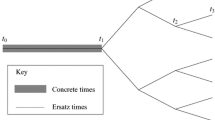Abstract
A proposal is made for a fundamental theory, in which the history of the universe is constituted of diverse views of itself. Views are attributes of events, and the theory’s only be-ables; they comprise information about energy and momentum transferred to an event from its causal past. A dynamics is proposed for a universe constituted of views of events, which combines the energetic causal set dynamics with a potential energy based on a measure of the distinctiveness of the views, called the variety (Smolin in Found Phys 46(6):736–758, 2016). As in the real ensemble formulation of quantum mechanics (Barbour and Smolin in Variety, complexity and cosmology, arXiv: hep-th/9203041), quantum pure states are associated to ensembles of similar events; the quantum potential of Bohm then arises from the variety.
Similar content being viewed by others
Notes
Causal set models of quantum spacetime were introduced in [1] Energetic causal set models differ from other spacetime-free causal set approaches, e.g. [2] proposed causal sets based on quantum information processing systems, and Ref. [3] proposed causal sets constructed out of standard model particles.
References
Bombelli, L., Lee, J., Meyer, D., Sorkin, R.D.: Spacetime as a causal set. Phys. Rev. Lett. 59, 521–524 (1987)
Markopoulou, F.: Quantum causal histories. Class. Quant. Grav. 17, 2059–2072 (2000). https://doi.org/10.1088/0264-9381/17/10/302. arXiv:hep-th/9904009
Furey, C..: Notes on algebraic causal sets, unpublished notes (2011). Cambridge Part III research essay (2006)
Cortês, M., Smolin, L.: The universe as a process of unique events. Phys. Rev. D 90, 084007 (2014). arXiv:1307.6167 [gr-qc]
Cortês, M., Smolin, L.: Energetic causal sets. Phys. Rev. D 90, eid 044035. arXiv:1308.2206 [gr-qc]
Cortês, M., Smolin, L.: Spin foam models as energetic causal sets. Phys. Rev. D 93, 084039 (2016). https://doi.org/10.1103/PhysRevD.93.084039. arXiv:1407.0032
Cortês, M., Smolin, L.: Reversing the irreversible: from limit cycles to emergent time symmetry. arXiv:1703.09696
Amelino-Camelia, G., Freidel, L., Kowalski-Glikman, J., Smolin, L.: The principle of relative locality. Phys. Rev. D 84, 084010 (2011). [arXiv:1101.0931 [hep-th]]
Freidel, L., Smolin, L.: Gamma ray burst delay times probe the geometry of momentum space. arxiv:hep-th/arXiv:1103.5626
Smolin, L.: A real ensemble interpretation of quantum mechanics. Found. Phys. (2012). https://doi.org/10.1007/s10701-012-9666-4. arXiv:1104.2822
Smolin, L.: Quantum mechanics and the principle of maximal variety. Found. Phys. 46(6), 736–758 (2016). https://doi.org/10.1007/s10701-016-9994-x. arXiv:1506.02938
Unger, R.M., Smolin, L.: The singular universe and the reality of time. Cambridge University Press, Cambridge (2015)
Smolin, L.: Time Reborn. Houghton Mifflin Harcourt, Penguin and Random House Canada (2013)
Smolin, L.: Linking topological quantum field theory and nonperturbative quantum gravity J. Math. Phys. 36 (1995) 6417 gr-qc/9505028, CGPG-95/4-5, IASSNS-95/29
Wieland, W.M.: New action for simplicial gravity in four dimensions. Class. Quantum Gravity 32, 015016 (2015). arXiv:1407.0025
Barbour, J., Smolin, L.: Variety, complexity and cosmology. hep-th/9203041
Barbour, J., Bertotti, B.: Mach’s principle and the structure of dynamical theories. Proc. R. Soc. (Lond.) A 382, 295 (1982)
Konopka, T., Markopoulou, F., Severini, S.: Quantum graphity: a model of emergent locality. Phys. Rev. D 77 104029 (2008). https://doi.org/10.1103/PhysRevD.77.104029. arXiv:0801.0861
Acknowledgements
I wish to thank Marina Cortes and Roberto Mangabeira Unger, for their collaboration on the larger project of developing the hypothesis that time is fundamental and irreversible, of which this is a part. I am also grateful to Henrique Gomes for a careful reading of the manuscript. Finally, thank you to Julian Barbour for decades of conversation. This research was supported in part by Perimeter Institute for Theoretical Physics. Research at Perimeter Institute is supported by the Government of Canada through Industry Canada and by the Province of Ontario through the Ministry of Research and Innovation. This research was also partly supported by grants from NSERC, FQXi and the John Templeton Foundation. Funding were provided by John Templeton Foundation (Grant No. 999) and Canadian Network for Research and Innovation in Machining Technology, Natural Sciences and Engineering Research Council of Canada (CA).
Author information
Authors and Affiliations
Corresponding author
Rights and permissions
About this article
Cite this article
Smolin, L. The Dynamics of Difference. Found Phys 48, 121–134 (2018). https://doi.org/10.1007/s10701-018-0141-8
Received:
Accepted:
Published:
Issue Date:
DOI: https://doi.org/10.1007/s10701-018-0141-8




